While I’m a vegetarian every day of the week, I’ve begun dabbling in more vegan recipes as well. At first, it was about stretching my culinary skills to see how I could infuse familiar flavors without ingredients I often lean on (usually, dairy.) Then, egg prices went through the roof—but the constraint this put on my budget inspired a little creativity. Soon, I was experimenting with vegan baked goods. (I have a lot of aquafaba at my disposal thanks to my chickpea obsession.) And every step of the way, I found myself referring back to the goddess of all plant-based recipes: Nisha Vora.
As I dove into her inspiring archive of recipes, I found myself happy dancing in the kitchen with each ensuing success. Nisha is a cookbook author and recipe developer behind the vegan food site, Rainbow Plant Life. Her creations run the gamut from elevated comfort food to weeknight recipes to globally-inspired flavors—all through the lens of vegan cooking.
And yes, each recipe—from her Crispy Baked Mac and Cheese to Palak Paneer taste so good you’d never think twice about the recipes being vegan. In the spirit of finding more ways to bring vegan cooking to all of our kitchens, we asked Nisha for all the inspiration. Below, she shares her tips for incorporating more plant-based meals into your week as well as the recipe for one of her go-to meals. (Trust me, her Vegan Indian Braised Chickpea Stew ticks all the boxes and more. Scroll to the bottom for the recipe!)
Nisha Vora Shares Her Best Vegan Cooking Tips
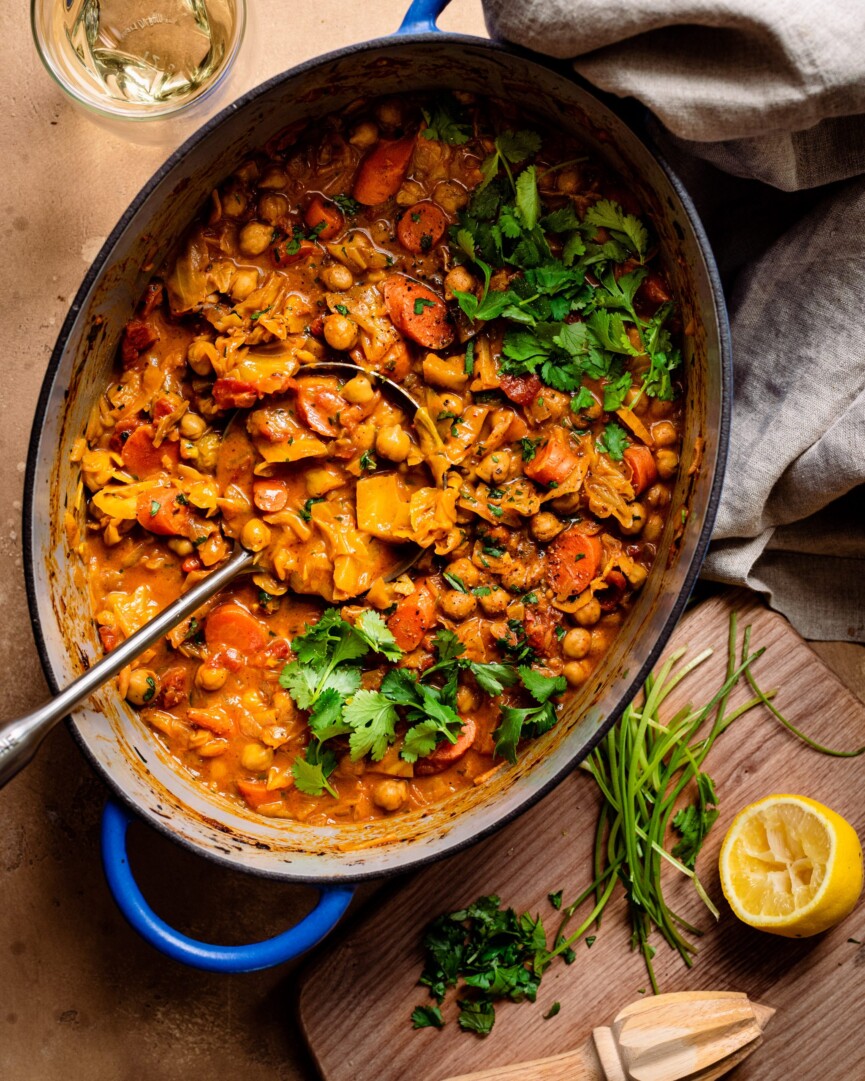
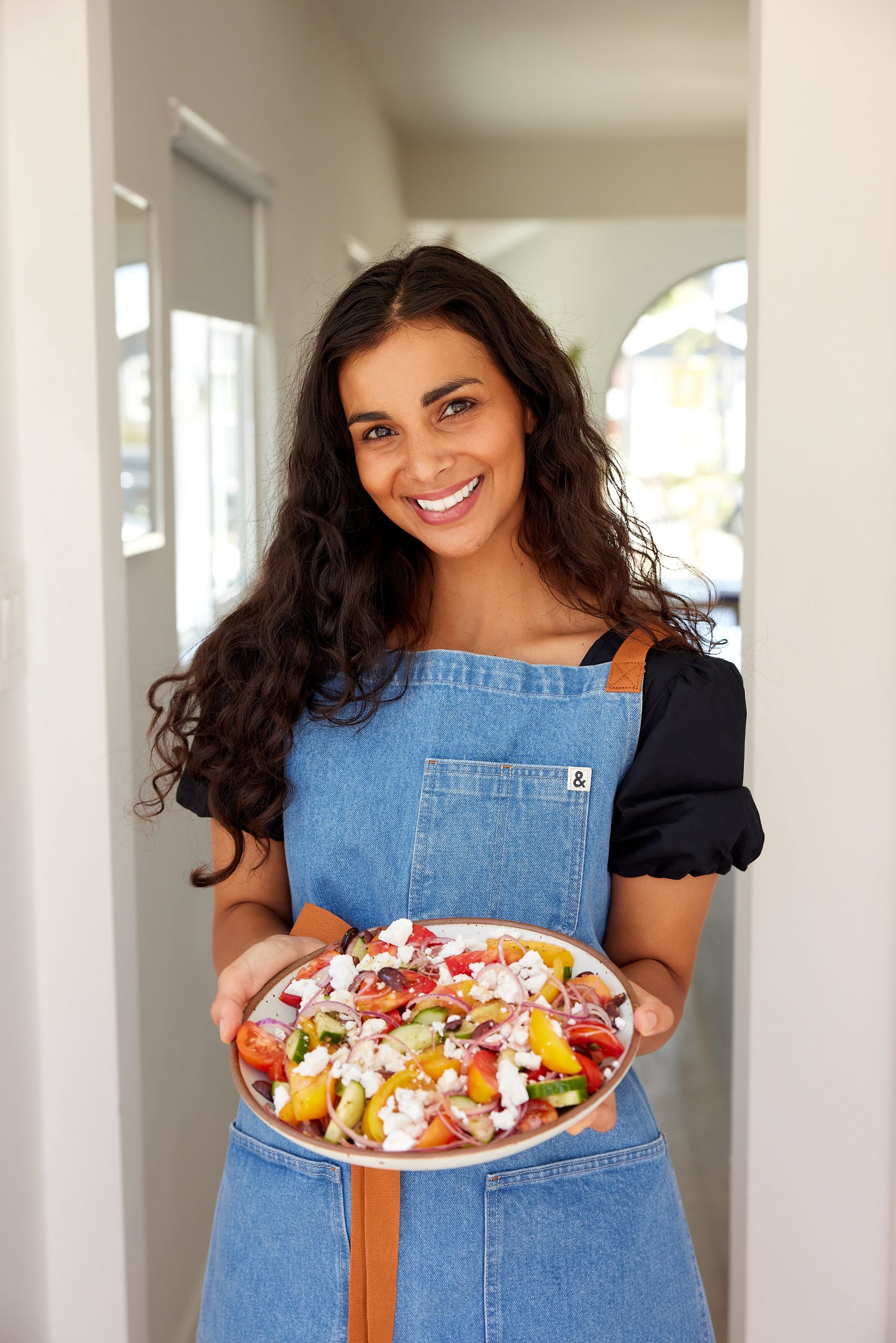
Nisha Vora is a vegan recipe developer, food blogger, and cookbook author. After graduating from Harvard Law School and working as a lawyer for four years, she exchanged her case books for cookbooks and launched her dream career. On her website Rainbow Plant Life, she shares unique, flavor-packed plant-based recipes, and on YouTube, she is known for her funny yet educational cooking videos. Nisha’s first cookbook, The Vegan Instant Pot Cookbook, was published in 2019. She is currently working on her next cookbook.
When did you first start cooking vegan? How has it influenced your food philosophy?
Life is just too short to eat mediocre food! After nearly two decades of struggling with disordered eating and feeling trapped by diet culture, I am now happily at the place where I refuse to eat food that doesn’t bring me joy. When I first went vegan in 2016, I had to relearn how to build flavor because I could no longer rely on culinary crutches like parmesan cheese. This felt like an obstacle at first, but it quickly made me a more creative (and better) cook.
Instead of revolving my meals around a slab of meat, I started coming up with ideas of how to infuse main character energy into nutrient-dense ingredients like lentils and cauliflower. I found that pantry staples I had previously overlooked could supercharge countless dishes with big flavor. And I learned that you could recreate incredibly indulgent comfort foods using ingredients like cashews and tofu.
Since going vegan, this whole new world of flavors and cuisines opened to me. Instead of keeping something basic like chicken breast + quinoa + roasted vegetables in heavy rotation, I now rely on flavor-heavy ingredients like Korean gochujang, Japanese umeboshi paste, and Indian curry leaves to build meals with big flavor.
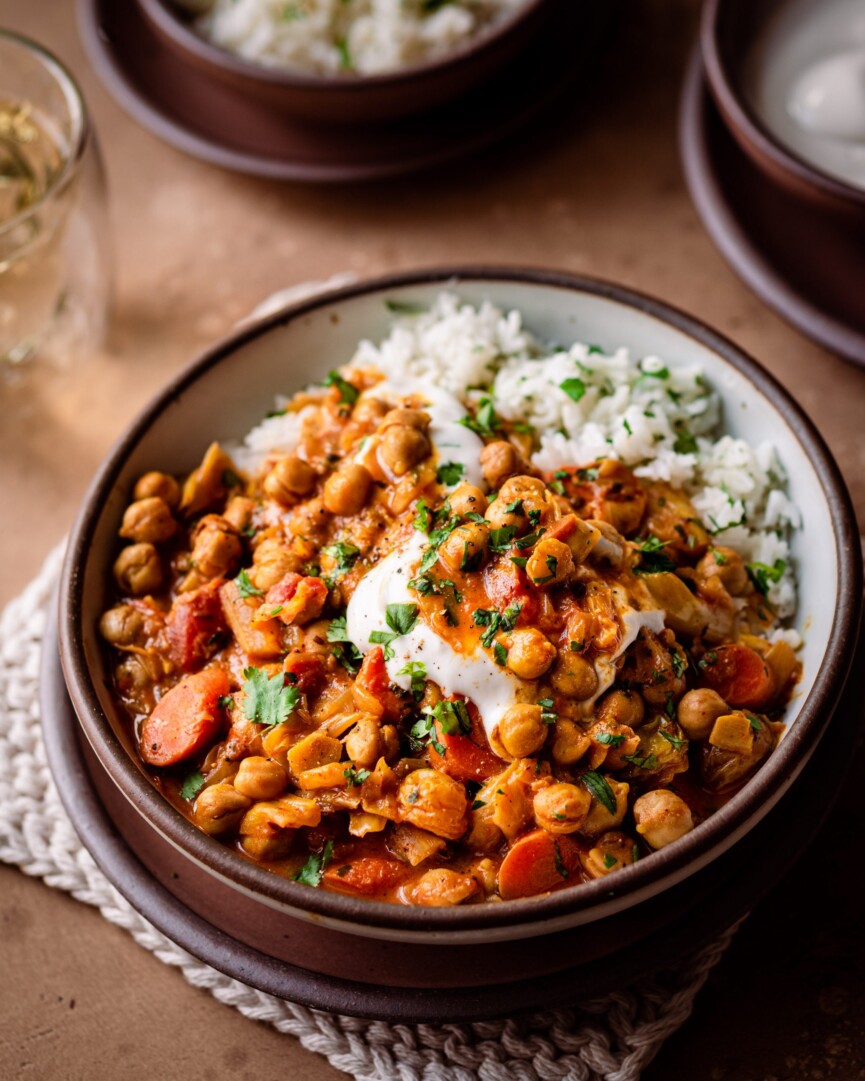
How did you develop this Braised Indian Chickpea Stew recipe?
Two years ago, I had just started testing recipes for my second cookbook (which will be published in 2024). One of the recipes was an oven-braised bean stew with white wine and vegan butter. It felt very French. And I thought, wouldn’t it be fun to mash-up these French techniques with Indian flavors?
It’s not a traditional Indian recipe and not quite a curry, hence the name “stew,” but it has all the bold flavors you love about Indian food in a wholesome plant-based package.
What makes this recipe your go-to?
I love making this recipe in winter because it feels so hearty but it’s very good for you and feels like a warm hug from your favorite auntie. Plus, after you do some light sautéing, the entire pot gets sent to the oven for an hour. Which is a solid amount of time to do something else, like have happy hour with my partner on the couch. Or something less fun, like doing laundry.
Is there a kitchen tool you recommend we have to make this?
You’ll need a Dutch oven or a stove-to-oven braising pan. A Dutch oven is a workhorse pan for me because I make a lot of stews and soups, and it can seamlessly go from stove to oven. It also retains heat well, much better than, say, a nonstick soup pot.
While you don’t absolutely need to grind your own spices to make this recipe, it makes a noticeable difference in the flavor of the finished dish. A spice grinder is very helpful here unless you have strong forearms (or a mortar and pestle).
And of course sharp, good-quality knives are a must in my kitchen.
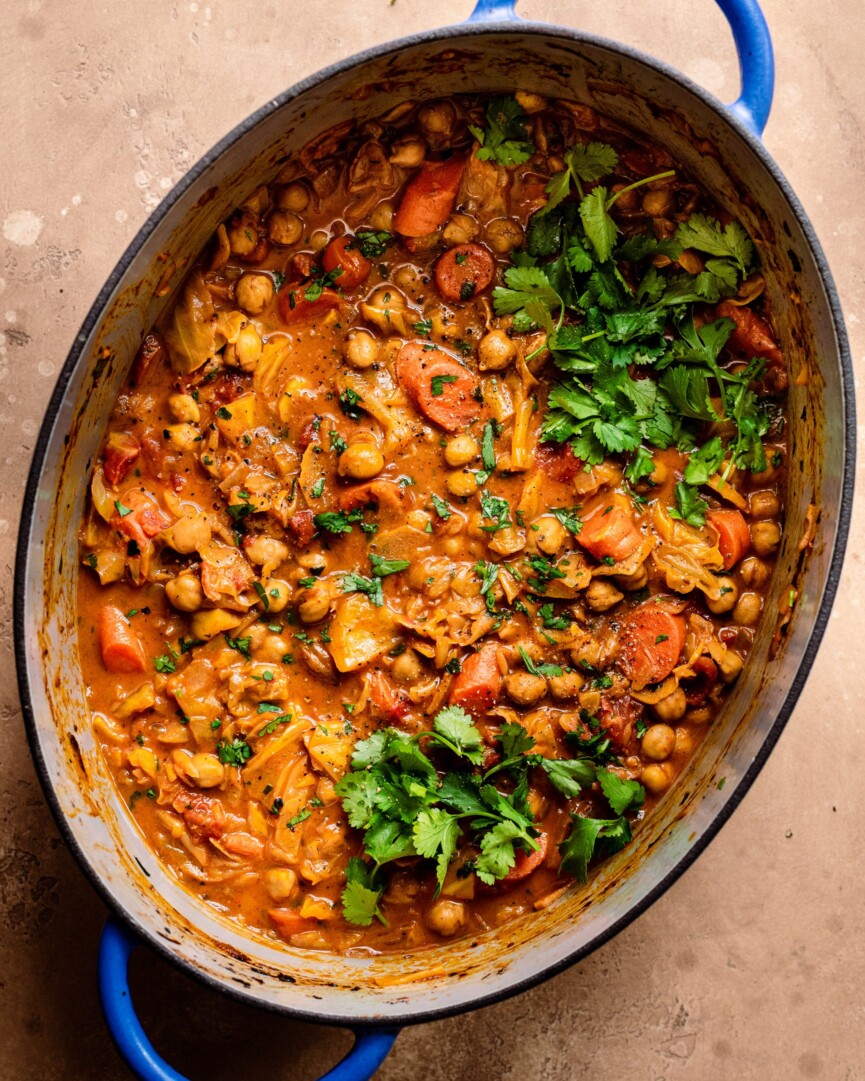
What stand-out ingredients make this recipe special?
Cabbage features heavily here, and while that might not sound exciting, it really shines. It starts out crunchy and rubbery, but when sautéed and then braised, it releases its sugars and becomes slightly sweet and almost buttery-rich. It’s also so inexpensive.
Green cardamom is one of the spices used here, and it brings this subtly sweet, almost heady aroma that works really well with the golden raisins. Raisins might sound weird, but they lend these pops of sweetness that temper the heat and acidity in this stew (they get delightfully plump and juicy when braised).
Can we make any ingredient swaps with this recipe?
While you’ll get the best results with whole spices, there are ground spice substitutes provided in the blog post. If you don’t consume wine, you can omit and deglaze with vegetable broth and finish with an extra squeeze of lemon as needed. If you’re not a fan of raisins, omit them. Add a teaspoon of sugar at the end as needed to balance the heat and tang.
What are your favorite kitchen tricks and cooking hacks?
Layering spices and aromatics! This technique is used heavily in Indian cuisine and is something I learned from my mom. Many Indian recipes, including this Indian-inspired stew, start by blooming whole spices (toasting them in oil). Since spices are fat-soluble, this process releases the spices’ volatile oils, where all the flavor lives. Afterward, aromatics like onions, garlic, and ginger are sautéed, followed by a brief toasting of ground spices. This layering process gives you the big bold flavors Indian food is associated with, but you can use this technique across so many cuisines and dishes.
What advice would you share with someone who is interested in, but might feel intimidated by, vegan cooking?
If you’re feeling intimidated, start small. Pick one night a week to make your “vegan night” and commit to making one vegan recipe a week. For most people, once they see how good a meal without animal products can be, they tend to be open to trying it more.
And 2023 is the best possible time to cook more vegan food and to go vegan. There are so many amazing content creators out there sharing vegan-ized versions of comfort foods from every corner of the globe. If you follow these creators on Instagram or YouTube, it’s really hard to not get inspired. And you can make it more fun by doing this along with a friend or family member.
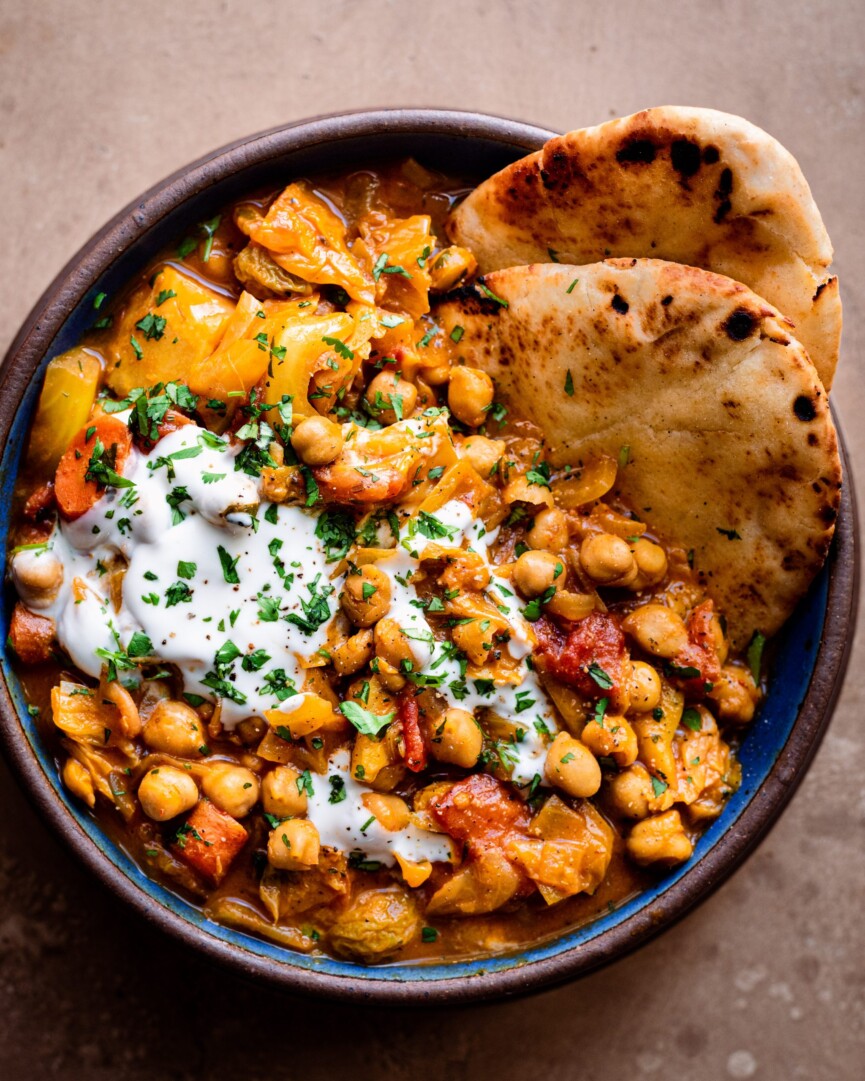
What do you hope people feel or learn when they make one of your recipes?
The most gratifying part for me is hearing from readers about the impact my recipes have on their everyday life. Sometimes, it’s something big, like they’ve never been able to stick with a vegan diet until they started trying my recipes. Other times, it’s something smaller, like they have a kid with lots of allergies and dinnertime is usually stressful, but one of my recipes came to the rescue last night.
Food brings so much joy and connection, and is truly the best way to bring people together. I hope that people experience a little bit of that when they make and eat one of my recipes.
Are there any other recipes from your site that you think readers should cook first?
My lentil curry has been a fan favorite for the last five years, so I would start there. It’s easy, approachable, and just very delicious. If you’re really not into lentils, I have another curry with tofu that’s pretty fantastic. They’re both great for meal prep, too.
For breakfast, try a tofu scramble or vegan pancakes.
And if you’re a chocolate fiend like me, definitely bake some vegan brownies. (Editor’s note: Be sure to save your aquafaba from the Braised Indian Chickpea Stew!)
Find more of Nisha’s recipes at Rainbow Plant Life, where you can find all of her recipes in printable form. And follow along on Instagram or YouTube for more inspiring vegan content.
Print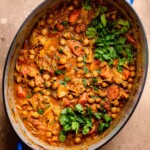
Braised Indian Chickpea Stew
Description
This Indian-inspired chickpea stew features lots of warming spices, chickpeas, cabbage, and carrots.
Ingredients
- 3 tablespoons grapeseed oil
- 1 large yellow onion, chopped
- 4 medium carrots, sliced on the bias*
- 1/2 of a medium cabbage, roughly chopped (16-18 ounces or 450–510g)
- 4 garlic cloves, thinly sliced
- 2– inch (5 cm) piece of fresh ginger, grated or minced
- Kosher salt & freshly cracked black pepper
- 3 tablespoons tomato paste
- 1 – 1 1/2 teaspoons Indian red chili powder
- 1 teaspoon ground turmeric
- 1/4 teaspoon ground nutmeg
- 3/4 cup (180 mL) dry white wine
- 1 1/2 cups (360 mL) vegetable broth (plus a little more as needed)
- 2 (15-ounce/425g) cans chickpeas, drained and rinsed
- 2 bay leaves
- 1/3 cup (55g) golden raisins (sultanas)
- 1 (14.5-ounce/410g) can diced tomatoes
- 1 cup (240 mL) full-fat canned coconut milk, stirred well
- Whole Spices: 6 whole green cardamom pods, 4 whole cloves, 1 teaspoon cumin seeds, 1 teaspoon coriander seeds, 1 teaspoon fennel seeds, 2 cinnamon sticks (2-3 inches long)
- For finishing: 1 teaspoon garam masala, 3/4 cup (9g) cilantro leaves chopped, plus more for garnish, Lemon juice (a few squeezes), 1-2 teaspoons organic cane sugar, as needed
- To serve: Coconut yogurt or other vegan yogurt, white rice, brown rice, or Indian flatbread such as naan or roti
Instructions
- Roughly grind the whole spices. Add the cardamom pods, cloves, cumin seeds, coriander seeds, and fennel seeds (not the cinnamon sticks) to a spice grinder or mortar, or pestle. Coarsely grind (just a few pulses with an electric grinder) – you want some texture to remain. Remove the empty cardamom pod shells.
- Preheat the oven to 350°F/175°C.
- Heat a Dutch oven or stove-to-oven braising pan over medium heat with 1 tablespoon of the oil. Once the oil is shimmering, add the roughly ground spices *and* the cinnamon sticks. Sauté for 60 seconds or until very fragrant, tossing frequently to prevent burning.
- Add the remaining 2 tablespoons of oil to the pan. Next, add the onions, carrots, and cabbage. Season with ½ teaspoon kosher salt. Cook until the vegetables start to soften, 6 to 8 minutes. Add the garlic and ginger, and cook for another 2 minutes.
- Add the tomato paste and stir frequently for 2 minutes to coat everything. If things start to dry out or seem like they might burn, add a splash or two of water and scrape up the browned bits. Add in the Indian red chili powder, turmeric, and nutmeg, and stir frequently for 1 minute.
- Deglaze the pan with the white wine, scraping up the browned bits and fond from the bottom of the pan. Cook until the wine is mostly evaporated and the smell of alcohol has dissipated, about 2 minutes.
- Pour in the vegetable broth, chickpeas, bay leaves, raisins, tomatoes, and 1 ½ teaspoons of kosher salt and black pepper to taste. Stir well to combine and bring to a simmer. Allow to simmer for 2-3 minutes, stir again, and then turn off the heat.
- Put the lid on the pan, or if it doesn’t have a lid, cover tightly with foil. Transfer the pan to the preheated oven and braise for 1 hour, until the chickpeas and vegetables are soft. At the halfway mark, check to see if the liquid has evaporated somewhat. If so, add additional vegetable broth or water (about 1/4 cup).
- Pour in the coconut milk and return the pan to the oven to braise for another 10 minutes. Take out of the oven and discard the bay leaves and cinnamon sticks.
- Stir in the garam masala, cilantro, and a squeeze of lemon juice. Taste for seasonings, adding more salt or pepper as needed. If it’s slightly too acidic, stir in a teaspoon or two of sugar.
- Serve warm with Indian flatbread or over a bed of rice. Dollop on some vegan yogurt before serving or serve on the side.


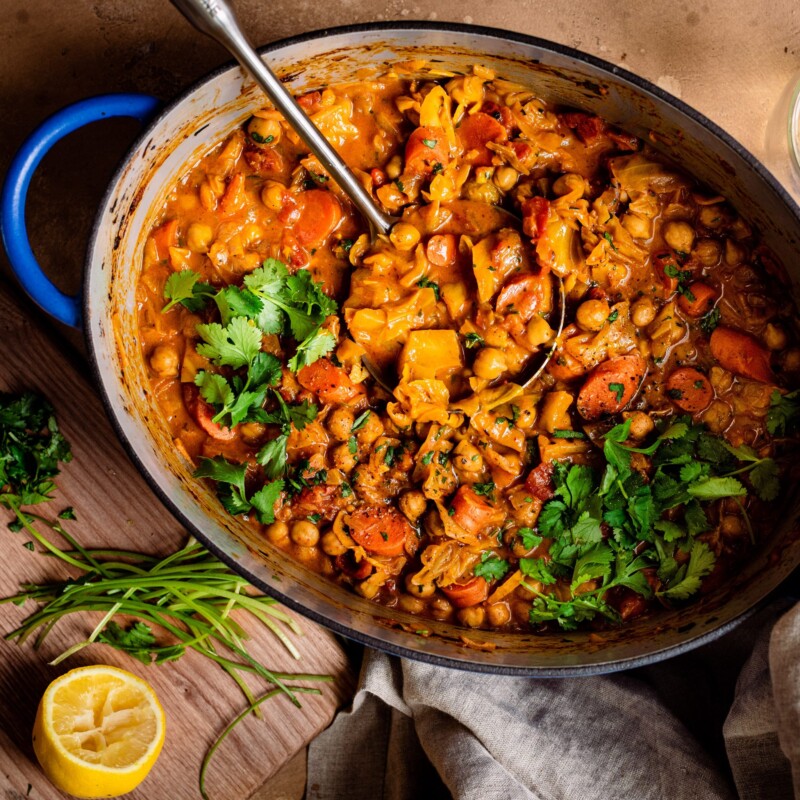
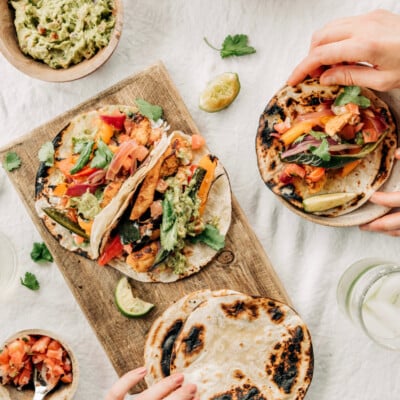
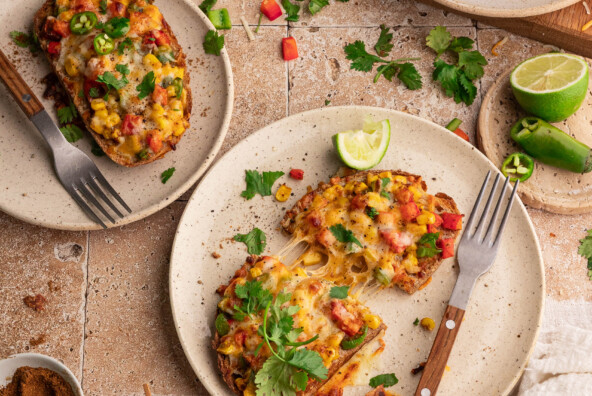
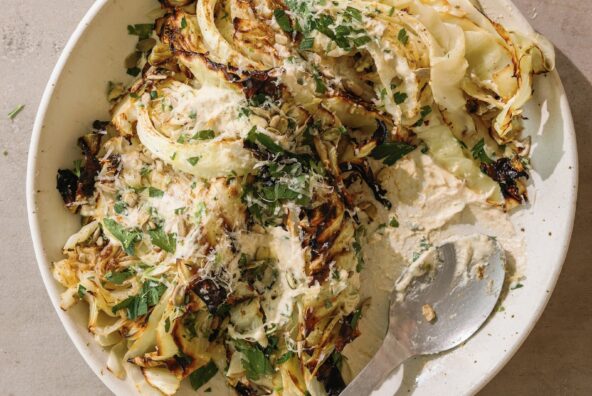

Ok wow! This was good! It was a lot of work but delish!
★★★★★